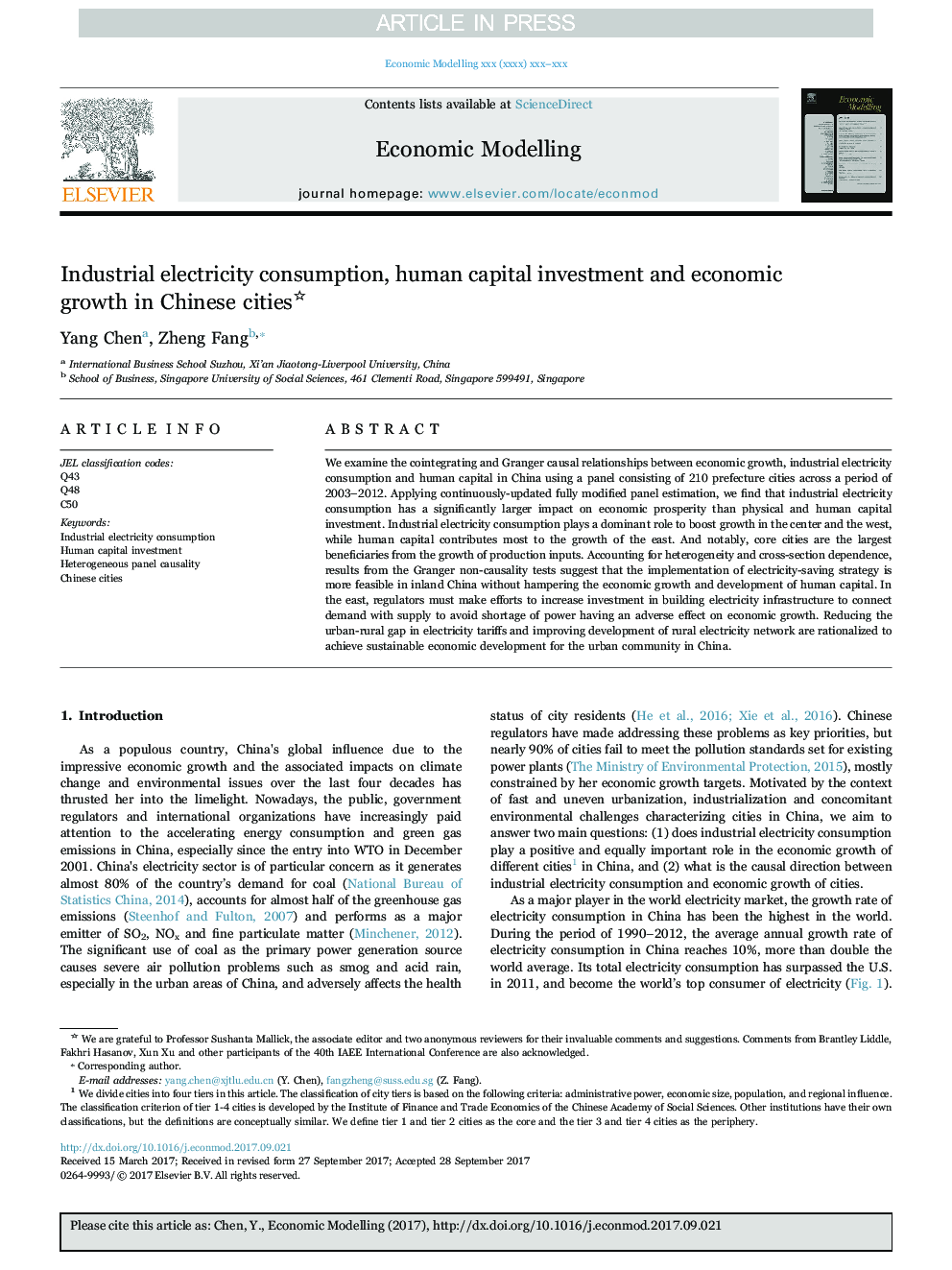| کد مقاله | کد نشریه | سال انتشار | مقاله انگلیسی | نسخه تمام متن |
|---|---|---|---|---|
| 7347477 | 1476500 | 2018 | 15 صفحه PDF | دانلود رایگان |
عنوان انگلیسی مقاله ISI
Industrial electricity consumption, human capital investment and economic growth in Chinese cities
ترجمه فارسی عنوان
مصرف برق صنعتی، سرمایه گذاری انسانی و رشد اقتصادی در شهرهای چینی
دانلود مقاله + سفارش ترجمه
دانلود مقاله ISI انگلیسی
رایگان برای ایرانیان
ترجمه چکیده
ما از همکاری و گرنجر رابطه علی بین رشد اقتصادی، مصرف برق صنعتی و سرمایه انسانی در چین، با استفاده از یک هیئت متشکل از 210 شهر رفاه در طول دوره 2003-2012، بررسی می کنیم. با استفاده از برآورد پانل به اصطلاح به طور مداوم به روز شده به روز شده، ما دریافتیم که مصرف برق صنعتی تاثیر بسزایی در رشد اقتصادی دارد تا سرمایه گذاری فیزیکی و انسانی. مصرف الکتریسیته مصرفی صنعتی نقش مهمی را برای افزایش رشد در مرکز و غرب ایفا می کند، در حالی که سرمایه انسانی بیشتر به رشد شرق کمک می کند. به طور مشخص، شهرهای اصلی بیشترین سود را از رشد تولیدات تولید می کنند. حسابداری برای عدم همبستگی و وابستگی متقابل، نتایج آزمون گرنجر غیر علیت نشان می دهد که اجرای استراتژی صرفه جویی در برق در چین داخلی امکان پذیر نیست و مانع رشد اقتصادی و توسعه سرمایه انسانی نمی شود. در شرق، رگولاتورها باید تلاش کنند تا سرمایه گذاری در ساخت زیرساخت های برق را برای اتصال تقاضا با عرضه به منظور جلوگیری از کمبود قدرت تاثیر منفی بر رشد اقتصادی داشته باشند. کاهش میزان شکاف شهری و روستایی در تعرفه های برق و بهبود توسعه شبکه های برق روستایی به منظور دستیابی به توسعه اقتصادی پایدار برای جامعه شهری در چین منطبق است.
موضوعات مرتبط
علوم انسانی و اجتماعی
اقتصاد، اقتصادسنجی و امور مالی
اقتصاد و اقتصادسنجی
چکیده انگلیسی
We examine the cointegrating and Granger causal relationships between economic growth, industrial electricity consumption and human capital in China using a panel consisting of 210 prefecture cities across a period of 2003-2012. Applying continuously-updated fully modified panel estimation, we find that industrial electricity consumption has a significantly larger impact on economic prosperity than physical and human capital investment. Industrial electricity consumption plays a dominant role to boost growth in the center and the west, while human capital contributes most to the growth of the east. And notably, core cities are the largest beneficiaries from the growth of production inputs. Accounting for heterogeneity and cross-section dependence, results from the Granger non-causality tests suggest that the implementation of electricity-saving strategy is more feasible in inland China without hampering the economic growth and development of human capital. In the east, regulators must make efforts to increase investment in building electricity infrastructure to connect demand with supply to avoid shortage of power having an adverse effect on economic growth. Reducing the urban-rural gap in electricity tariffs and improving development of rural electricity network are rationalized to achieve sustainable economic development for the urban community in China.
ناشر
Database: Elsevier - ScienceDirect (ساینس دایرکت)
Journal: Economic Modelling - Volume 69, January 2018, Pages 205-219
Journal: Economic Modelling - Volume 69, January 2018, Pages 205-219
نویسندگان
Yang Chen, Zheng Fang,
